p Block Elements on Periodic Table – Introduction, Properties & Trends

What are the p-Block Elements? p block elements are those in which the last electron enters any of the three ...
Read moreGroup 13 Elements (Boron Family)-Properties, Compounds, Behaviour

What Are Group 13 Elements? Group 13 elements are the first group in the p-block of the periodic table. All ...
Read moreBoron Family-Elements, Configurations, Periodic trend, Physical & Chemical Properties, FAQs

About Boron Family Boron got its name from the Arabic word ‘buraq’ which is the name of borax. It belongs ...
Read moreBorax-Chemical Formula(Sodium Borate), Structural Formula, Borax Reaction, Natural Sources of Borax, Uses

What is Borax? Borax is a compound consisting of an elementary substance called boron, united with oxygen and soda. Borax ...
Read moreBoric Acid (H3BO3) Uses-Preparation, Properties, Structure, Medicine & Poison, Uses, FAQs

What is Boric Acid (H3BO3)? Boric Acid is a monobasic Lewis acid with the chemical formula H3BO3. Boric acid is ...
Read moreDiborane- Structure, Preparation, Properties, Reactions, Uses, Applications

Diborane is a chemical compound that consists of boron and hydrogen atoms and has a molecular formula B2H6. This substance ...
Read moreAluminum-Atomic Mass, Electron Configuration, Chemical Properties, Uses, FAQs

What is Aluminium? Aluminium is a soft, silvery-white, ductile, nonmagnetic metal in the boron group. It is the third most abundant ...
Read moreGroup 14 Elements (Carbon Family) – Properties, Compounds, Behaviour, FAQs

What Are Group 14 Elements? Group 14 elements are the second group in the p-block of the periodic table. It ...
Read moreCarbon and its compounds-Definition, Catenation, Nature, Allotropy & FAQs

What are Carbon and its Compounds? The molecules of a carbon compound must contain an atom of carbon. All living ...
Read moreAllotropes of Carbon – Properties, Structure of Carbon Allotropes, Graphite, Diamond, Fullerenes

The phenomenon by which an element can exist in more than one physical state is called allotropy. The allotropes of carbon ...
Read morePhysical And Chemical Properties Of Carbon | Chemistry

Physical Properties of Carbon Chemical Properties of Carbon Carbon compounds in fuels like diesel This is because when carbon or ...
Read moreUses Of Oxides of Group 14 Elements (Carbon Group)

Group 14 elements of the modern periodic table are also known as carbon group elements. These elements have 4 valence ...
Read moreSilicon Compounds-Silicones, Silicates and Zeolites

What is Silicon? Silicon is an element with the atomic number 14 and represented by the symbol Si in the ...
Read moreNCERT Solutions: p-Block Elements for Class 11 Chemistry

The p-block elements are between the 13th group and the 18th group in the periodic table. Since this chapter covers ...
Read moreNitrogen Family-Group 15 Elements, Periodic Trends, Physical & Chemical Properties, Anomalous Properties of Nitrogen

The contemporary periodic table, devised by Dimitri Mendeleev, lists all known elements according to their atomic number, which is unique ...
Read moreDinitrogen(N2)-Preparation, Reactions, Properties, Uses, Nitrogen Cycle, Occurence, FAQs

Nitrogen is the lightest element in Periodic Table Group 15, also known as the pnictogens. Dinitrogen, a colourless and odourless ...
Read moreAmmonia(NH3)-Structure, Physical & Chemical Properties, Preparation, Uses, FAQs

Ammonia (NH₃) is a colorless gas with a sharp, pungent odor. It is a compound of nitrogen and hydrogen and ...
Read moreOxides of Nitrogen-Preparation, Properties, Structure, Uses of Nitrogen Dioxide (NO2), Nitric Acid (HNO3), Nitrous Oxide (N2O), Nitric oxide (NO), FAQs

Nitrogen combines with oxygen to generate nitrogen oxides in a variety of forms. Its oxides have distinct oxidation states, ranging ...
Read moreAllotropes of Phosphorus, White Phosphorus, Red Phosphorus , Black Phosphorus, Phosphorus Trichloride (PCl3), Phosphorus Pentachloride (PCl5)

Phosphorus is an element that cannot be found naturally in our environment. It is highly reactive. Phosphorus is a chemical ...
Read morePhosphine(PH3)-Structure, Preparation, Properties, Uses, FAQs

The final electron of a P block element enters one of the three p-orbitals of the shell in which it ...
Read morePhosphorus Halides-Structure, Properties, Uses, Effects of Phosphorus Trichloride(PCl3) & Phosphorus Pentachloride (PCl5)

Phosphorus is required for life, mostly through phosphates, which are molecules that contain the phosphate ion. Phosphates are found in ...
Read moreOxoacids of Phosphorus-Phosphorus acid, Phosphoric acid, Hypophosphoric Acid, Pyrophosphoric Acid, Orthophosphoric Acid, Structures, Properties, Uses, FAQS

Oxoacids are acids that contain oxygen. Phosphorus is one such element that can be used to create a variety of ...
Read moreGroup 16 Elements(Oxygen family)-Chalcogens, Isolation, Physical & Chemical Properties

Chalcogens are the Group 16 elements of the modern periodic table consisting of 5 elements oxygen, sulphur, selenium, tellurium and ...
Read moreDioxygen(O2)-Physical & Chemical Properties, Preparation, Laboratory & Industrial Preparation, Uses, FAQs

Oxygen is a member of the periodic table’s chalcogen group, a highly reactive nonmetal, and an oxidizing agent that readily ...
Read moreSimple Oxides-Types, Acidic Basic Neutral Oxides, Examples, FAQs

What are Oxides ? Oxides are binary chemicals generated when oxygen reacts with other elements. In nature, oxygen is extremely ...
Read moreOzone-Preparation, Properties, Uses, Ozone Layer Depletion Effects, FAQs

What is Ozone ? Ozone is too reactive to stay in the atmosphere at sea level for long. It is ...
Read moreAllotropes of Sulphur-Rhombic sulphur (α-sulphur), Monoclinic sulphur (β-sulphur), Colloidal Sulphur, Physical & Chemical Properties of Sulphur

Sulphur is the tenth most prevalent element in the universe. It can also be found in the form of sulphide ...
Read moreSulphur Dioxide(SO2)-Structure, Preparation, Properties, Uses

The p-block, which spans groups 13 to 18, is located on the right side of the normal periodic table. Their ...
Read moreOxoacids of Sulphur-Sulphuric acid, Sulphurous acid, Peroxodisulphuric acid, Pyrosulphuric Acid, Thiosulphuric acid, Dithionic acid, Properties, Uses, FAQs

What are Oxoacids of Sulphur ? Oxoacids are oxygen-containing acids. Many oxoacids, such as H2SO4, H2SO3, and others, are known ...
Read moreSulfuric Acid (H2SO4)–Structure, Formula, Contact Process & Lead Chamber Process for Manufacturing of Sulfuric Acid, Molecular Mass & Uses, FAQs

Sulfuric Acid or Sulphuric Acid is a mineral acid consisting of one Sulfur, four Oxygen, and two Hydrogen atoms. The ...
Read moreGroup 17 Elements(Halogens)-Electronic Configuration, Oxidation State, Physical & Chemical Properties, Characteristics, Uses, FAQs

What are Halogens ? Halogens are the elements in the periodic table of Group 17 of the periodic table. Fluorine, ...
Read moreChlorine(Cl)-Structure, Physical & Chemical Properties, Isotopes, Uses, and FAQs

Chlorine is a chemical element that is represented by the symbol Cl. Chlorine is present in the 17th Group (Halogen ...
Read moreHydrogen Chloride(HCl)-Preparation, Physical & Chemical Properties, Synthesis, Harmfull Effects, Uses, FAQS

What is Hydrogen chloride ? Hydrogen chloride has the chemical formula HCl. It is a colourless gas at ambient temperature ...
Read moreOxoacids of Halogens-Properties, Structure,Hypochlorous Acid, Chlorous Acid, Perchloric Acid, Interhalogen Compounds, FAQs

The elements of Group 17 from top to bottom are fluorine, chlorine, bromine, iodine, and astatine. They are referred to ...
Read moreInterhalogen Compounds, Properties, Preparation, Uses, FAQs

The p-block elements are known to be those elements in which the electron enters in one of the three orbitals ...
Read moreGroup 18(Noble or Inert Gas Elements)-Characteristics, Physical & Chemical Properties, Trends, Characteristics, FAQs

Noble Gases have eight electrons in their outermost orbit (except helium which has two electrons). As a result, they have ...
Read morep-Block Elements:NCERT Solutions for Class 12 Chemistry, Important Questions

Class 12 Chemistry NCERT Solutions Chapter-p Block Elements – Important Questions Q 1:Discuss the general characteristics of Group 15 elements ...
Read morep-Block Elements:NCERT Exemplar Solutions for Class 12 Chemistry, Important Questions

p-Block Elements:NCERT Exemplar Solutions for Class 12 Chemistry I. Multiple Choice Questions (Type-I) 1. On addition of conc. H2SO4 to ...
Read moreP Block Elements MCQ Questions – Practice Questions of P Block Elements MCQ Chemistry with Answer & Explanations

The elements of group 13 to group 18 in the periodic table are collectively called P block elements. They are ...
Read morep-Block Elements MCQs with Answers Class 12 Chemistry

Class 12 chemistry MCQs with answers are provided here for chapter 7 The p-Block Elements. These MCQs are based on ...
Read moreP-Block Elements MCQs With Answers For Class 12 Chemistry JEE NEET

The p-Block Elements MCQs with Answers Practicing MCQs on p-block elements with provided answers is highly beneficial for NEET/JEE preparation. ...
Read morep-Block Elements-Assertion & Reason Questions for Class 12 Chemistry

Directions: These questions consist of two statements, each printed as Assertion and Reason. While answering these questions, you are required to ...
Read mored-Block Elements(Transition Elements)-Position of Elements in the Periodic Table, Properties, FAQs

Transition or d-block elements lies in the middle of the periodic table, from Group 3 to 12, are referred to ...
Read moreElectronic Configuration of the d-block Elements, Properties, Atomic and Ionic Radiii of d Block Element

Electronic Configuration of the d-block elements are those that can be found in the contemporary periodic table from the third ...
Read moreGeneral Properties of Transition Elements (d-block)-Oxidation State, Atomic Ionic Radii, Ionization Enthalpy, Metallic Radii and Densities, Boiling and Melting Points, Metallic Nature, Chemical Reactivity

Elements with partially filled d orbitals are known as transition elements (sometimes known as transition metals). Transition elements are defined ...
Read moreLanthanides Series(f-Block Elements)-Definition, Configuration, Properties, Lanthanide Contraction, Oxidation State, Chemical Reactivity, Formation of Coloured Ions

Lanthanides are the contemporary periodic table’s rare earth elements, with atomic numbers ranging from 58 to 71 after Lanthanum. Rare ...
Read moreActinide Series-Physical & Chemical Properties, Actinide Contraction, Coloured Ions, Ionization Enthalpies, Oxidation State, Formation of Complexes, FAQs

The d and f block mainly contains elements that include groups 3-12. The f block has elements in which 4f ...
Read moreApplications of d and f-block Elements for Class 12 Chemistry Notes

Transition metals are typically characterized as elements with or capable of forming partially filled ‘d’ orbitals. Transition elements are d-block ...
Read more